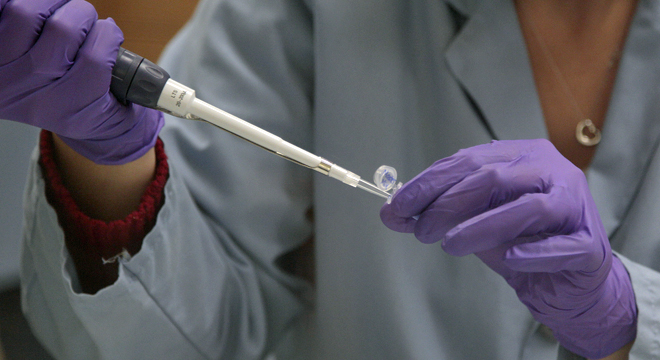(AP)—A second baby born with the AIDS virus may have had her infection put into remission and possibly cured by very early treatment — in this instance, four hours after birth.
Doctors revealed the case Wednesday at an AIDS conference in Boston. The girl was born in suburban Los Angeles last April, a month after researchers announced the first case from Mississippi. That was a medical first that led doctors worldwide to rethink how fast and hard to treat infants born with HIV, and the California doctorsfollowed that example.
In another AIDS-related development, scientists have modified genes in the blood cells of a dozen adults to help them resist HIV. The results give hope that this approach might one day free at least some people from needing medicines to keep HIV under control, a form of cure. That study was published in Thursday’s New England Journal of Medicine.
The Mississippi baby is now 3 1/2 and seems HIV-free despite no treatment for about two years. The Los Angeles baby is still getting AIDS medicines, so the status of her infection is not as clear.
A host of sophisticated tests at multiple times suggest the LA baby has completely cleared the virus, said Dr. Deborah Persaud, a Johns Hopkins University physician who led the testing. The baby’s signs are different from what doctors see in patients whose infections are merely suppressed by successful treatment, she said.
“We don’t know if the baby is in remission … but it looks like that,” said Dr. Yvonne Bryson, an infectious disease specialist at Mattel Children’s Hospital UCLA who consulted on the girl’s care.
Doctors are cautious about suggesting she has been cured, “but that’s obviously our hope,” Bryson said.
Most HIV-infected moms in the U.S. get AIDS medicines during pregnancy, which greatly cuts the chances they will pass the virus to their babies. The Mississippi baby’s mom received no prenatal care and her HIV was discovered during labor. Doctors started the baby on treatment 30 hours after birth, even before tests could determine whether she was infected.
The LA baby was born at Miller Children’s Hospital Long Beach, and “we knew this mother from a previous pregnancy” and that she was not taking her HIV medicines, said Dr. Audra Deveikis, a pediatric infectious disease specialist at the hospital.
The mom was given AIDS drugs during labor to try to prevent transmission of the virus, and Deveikis started the baby on them a few hours after birth. Tests later confirmed she had been infected, but does not appear to be now, nearly a year later.
The baby is continuing treatment, is in foster care “and looking very healthy,” Bryson said.
The Mississippi girl was treated until she was 18 months old, when doctors lost contact with her. Ten months later when she returned, they could find no sign of infection even though the mom had stopped giving her AIDS medicines.
Bryson is one of the leaders of a federally funded study just getting underway to see if very early treatment cancure HIV infection. About 60 babies in the U.S. and other countries will get very aggressive treatment that will be discontinued if tests over a long time, possibly two years, suggest no active infection.
“These kids obviously will be followed very, very closely” for signs of the virus, said Persaud, who described the LA case at the Conference on Retroviruses and Opportunistic Infections.
The study in adults was prompted by an AIDS patient who appears cured after getting a cell transplant seven years ago in Berlin from a donor with natural immunity to the virus. Only about 1 percent of people have two copies of the gene that gives this protection, and researchers have been seeking a more practical way to get similar results.
HIV usually infects blood cells through a protein on their surface called CCR5. A California company, Sangamo BioSciences Inc., makes a treatment that can knock out a gene that makes CCR5.
Dr. Carl June at the University of Pennsylvania tested it in 12 HIV patients who had their blood filtered to remove some of their cells. The treated cells were infused back into the patients.
Four weeks later, half of the patients were temporarily taken off AIDS medicines to see the gene therapy’s effect. The virus returned in all but one of them; that patient turned out to have one copy of the protective gene.
“We knew that the virus was going to come back in most of the patients,” but the hope is that the modified cells eventually will outnumber the rest and give the patient a way to control viral levels without medicines, said Dr. Pablo Tebas, one of the Penn researchers.
The National Institute of Allergy and Infectious Diseases sponsored the work with Sangamo and Penn.
“The ultimate goal is to create an immune system in the body that’s been edited genetically so the cells are not capable of being infected with HIV,” said director Dr. Anthony Fauci, “but we are a long way from there at this point.”
Jay Johnson, 53, who works for Action AIDS, an advocacy and service organization in Philadelphia, had the treatment more than three years ago. Although the virus rebounded when he temporarily went off HIVmedicines, tests show his modified blood cells are still multiplying.
“Hopefully one day I’ll be able to say I’m HIV negative again,” he said.
___
Online:
AIDS information: http://www.aidsinfo.nih.gov
and http://www3.niaid.nih.gov/topics/HIVAIDS/
___
Marilynn Marchione can be followed at http://twitter.com/MMarchioneAP
Copyright 2014 The Associated Press. All rights reserved. This material may not be published, broadcast, rewritten or redistributed.









